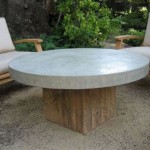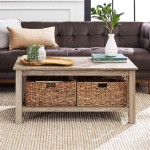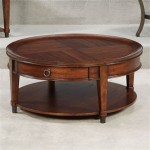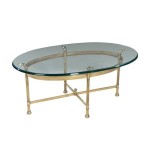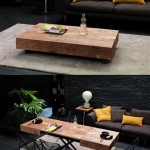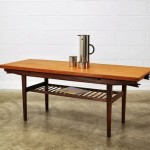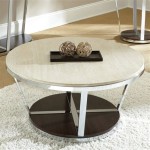Modern Living Room Table Decor: A Comprehensive Guide
The living room table, often a central element of the living space, serves as both a functional surface and a decorative focal point. Its decor plays a crucial role in setting the room's overall aesthetic and creating a welcoming atmosphere. Modern living room table decor embraces simplicity, clean lines, and a thoughtful selection of items that reflect personal style while complementing the existing interior design. The aim is to strike a balance between practicality and visual appeal, avoiding clutter and prioritizing a curated arrangement.
The choice of items to adorn a living room table is vast, ranging from books and decorative objects to plants and trays. The key to successful decorating lies in understanding the principles of design, considering the size and shape of the table, and selecting items that harmonize with the surrounding furniture and color palette. This article provides a comprehensive guide to modern living room table decor, exploring key considerations and offering practical tips for creating a stylish and functional space.
Understanding the Principles of Design
Before selecting any decor items, it is important to understand the fundamental principles of design. These principles provide a framework for creating visually appealing and balanced arrangements. Key principles include:
Balance: Balance refers to the distribution of visual weight within the arrangement. Symmetrical balance involves mirroring elements on either side of a central axis, creating a formal and traditional look. Asymmetrical balance, on the other hand, achieves equilibrium through the strategic placement of objects with varying sizes and shapes, resulting in a more dynamic and modern aesthetic. For instance, a stack of books on one side of the table can be balanced by a larger vase or sculptural object on the opposite side.
Proportion: Proportion refers to the relationship between the sizes of different objects within the arrangement and to the size of the table itself. Overcrowding the table with too many small items can create a cluttered look, while using only one or two large items can make the table appear empty and uninviting. A good rule of thumb is to vary the heights and sizes of the objects to create visual interest. Consider using a combination of tall objects, such as lamps or vases, and shorter objects, such as decorative boxes or candles.
Harmony: Harmony refers to the overall sense of unity and coherence within the arrangement. This can be achieved by selecting items that share a common theme, color palette, or style. For example, if the living room has a coastal theme, the table decor might include seashells, driftwood, and nautical-inspired accessories. Maintaining a consistent color palette, such as using different shades of blue and white, can also contribute to a sense of harmony.
Emphasis: Emphasis involves creating a focal point within the arrangement to draw the eye and create visual interest. This can be achieved by using a larger or more striking object as the centerpiece or by grouping smaller items together to create a unified visual impact. A bold floral arrangement, a unique sculpture, or a collection of antique books can all serve as effective focal points.
Selecting Decor Items
The selection of decor items is a crucial step in creating a stylish and functional living room table arrangement. The choices should reflect personal style and complement the existing decor of the room. Here are some common categories of items to consider:
Books: Books are a versatile and timeless addition to any living room table. They can be used as both decorative objects and functional reading material. When selecting books for decor, consider the cover design, color, and size. Stacking books horizontally or vertically can create visual interest and add height to the arrangement. Coffee table books with stunning photography or art are particularly popular for adding a touch of sophistication. Consider selecting books that align with personal interests, such as travel, art, or design. They can serve as conversation starters and add a personal touch to the space.
Trays: Trays are a practical and stylish way to organize and contain smaller objects on a living room table. They can be used to group items together, creating a sense of order and preventing clutter. Trays come in a variety of materials, shapes, and sizes, allowing for customization to suit individual needs and preferences. A tray can hold candles, coasters, remotes, or other small items that might otherwise clutter the surface. Consider using a decorative tray with an interesting pattern or texture to add visual interest to the arrangement. Metal trays, wooden trays, and woven trays are all popular options.
Candles and Candleholders: Candles and candleholders add warmth and ambiance to a living room. They can be used to create a cozy and inviting atmosphere, especially in the evenings. Choose candles in different sizes and shapes to create visual interest. Scented candles can also add a pleasant fragrance to the room. Consider using candleholders that complement the style of the living room. Glass candleholders, metal candleholders, and wooden candleholders are all popular choices. For a more modern look, consider using minimalist candleholders with clean lines. Grouping candles together in clusters can create a more dramatic effect.
Plants and Flowers: Plants and flowers bring life and freshness to a living room. They can add color, texture, and visual interest to the space. Choose plants that are appropriate for the lighting conditions in the room. Low-maintenance plants, such as succulents and cacti, are a good option for those who do not have a green thumb. Fresh flowers can add a touch of elegance to the arrangement. Consider using a variety of flowers in different colors and shapes. Vases are an important consideration when using plants and flowers. Choose vases that complement the style of the arrangement and the overall decor of the room. A simple glass vase can be used to showcase the beauty of the flowers, while a more ornate vase can add a touch of sophistication.
Decorative Objects: Decorative objects are a great way to add personality and style to a living room table arrangement. They can include sculptures, figurines, bowls, boxes, and other unique items. Choose objects that reflect personal interests and complement the overall decor of the room. Consider using objects with different textures and materials to add visual interest. A collection of antique boxes, a modern sculpture, or a set of decorative bowls can all add character to the space. When selecting decorative objects, consider the size and shape of the table. Avoid overcrowding the table with too many objects. Instead, choose a few carefully selected items that will make a statement.
Arrangement Techniques
Once the decor items have been selected, the next step is to arrange them on the living room table. There are several techniques that can be used to create a visually appealing and balanced arrangement. Understanding these techniques can help to create a cohesive and stylish look.
The Rule of Three: The rule of three is a design principle that suggests that objects arranged in odd numbers are more visually appealing than those arranged in even numbers. This is because odd numbers create a sense of asymmetry and imbalance, which can be more interesting to the eye. When arranging items on a living room table, try grouping them in sets of three, five, or seven. For example, a stack of books, a candle, and a small plant can create a visually appealing arrangement. Alternatively, a tray holding three different decorative objects can also achieve this effect.
Layering: Layering involves placing objects in front of or behind each other to create depth and dimension. This technique can add visual interest and prevent the arrangement from looking flat. For example, a small vase can be placed in front of a larger picture frame, or a stack of books can be placed behind a candle. Consider using objects with different heights and textures to create a more dynamic layered effect. Layering can also be achieved by using different materials, such as placing a metal object on top of a wooden surface or a glass object in front of a fabric-covered item.
Creating Height: Adding height to an arrangement can draw the eye upward and create a more dynamic visual impact. This can be achieved by using tall objects, such as lamps, vases, or stacks of books. Varying the heights of the objects within the arrangement can also create visual interest. For example, a tall vase with flowers can be placed next to a shorter candleholder, or a stack of books can be topped with a small decorative object. Avoid creating a perfectly symmetrical arrangement with all objects at the same height. Instead, strive for a balanced asymmetry that creates a sense of visual flow.
Negative Space: Negative space refers to the empty space around and between objects in an arrangement. Leaving some empty space can prevent the arrangement from looking cluttered and overcrowded. It allows the eye to rest and appreciate the individual objects without feeling overwhelmed. When arranging items on a living room table, be mindful of the negative space. Avoid filling every available space with objects. Instead, leave some areas open to create a sense of balance and serenity. This is particularly important for smaller tables or tables in smaller living rooms, where too much decor can make the space feel cramped.
Symmetry vs. Asymmetry: Choosing between a symmetrical and asymmetrical arrangement depends on the desired aesthetic and the overall style of the living room. Symmetrical arrangements create a formal and traditional look, while asymmetrical arrangements create a more dynamic and modern look. A symmetrical arrangement involves mirroring elements on either side of a central axis. This can be achieved by placing identical objects on either side of the table or by creating a balanced arrangement with similar objects. An asymmetrical arrangement, on the other hand, achieves equilibrium through the strategic placement of objects with varying sizes and shapes. This requires a more careful consideration of balance and proportion, but it can result in a more visually interesting and unique arrangement.
By applying these principles of design and utilizing effective arrangement techniques, anyone can create a stylish and functional modern living room table decor that enhances the overall aesthetic of the living space.

Modern Coffee Table Decorating Ideas For Your Living Room

20 Super Modern Living Room Coffee Table Decor Ideas That Will Amaze You Feelitcool Romantic Home

27 Coffee Table Decor Ideas How To Style A Modern

20 Super Modern Living Room Coffee Table Decor Ideas That Will Amaze You Feelitcool Com Rooms Home

Modern Coffee Table Decorating Ideas For Your Living Room

29 Fresh Ideas For Pro Style Living Room Table Décor

Living Room Decor Ideas Inspiration Parachute Blog

Modern Coffee Table Decorating Ideas For Your Living Room

How To Style Your Modern Center Table

Center Table Decoration Ideas To Elevate Your Living Room Décor
Related Posts

